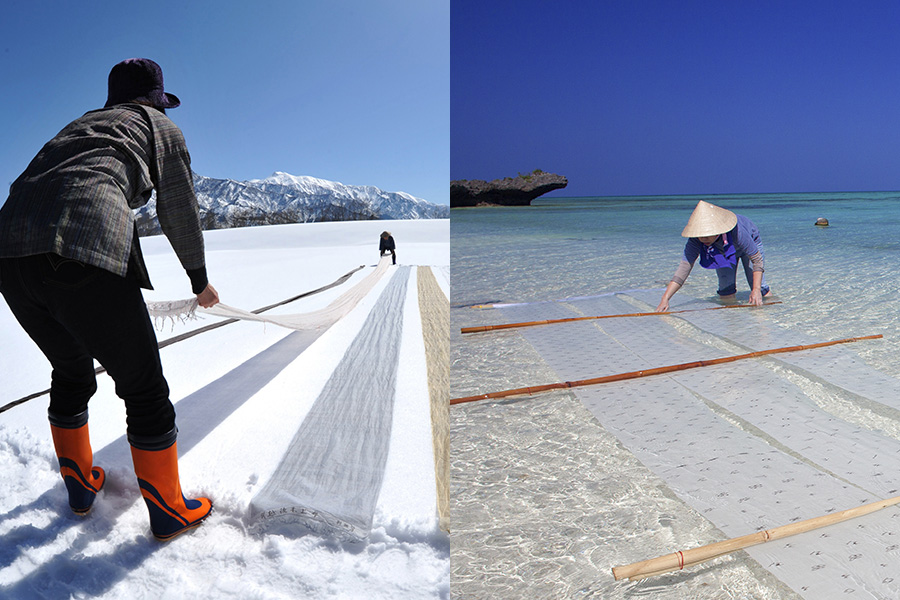Jofu Fabric: From the Snowy North to the Sunny Southern Seas

Right: Umi-zarashi is used to make Yaeyama-jofu. (Photo courtesy of Ohmori Kazuya)
Jofu is the pinnacle of Japanese Asa fabric, which for a long time used to be presented to the imperial court and families of the shogunate. It's made from fibers of ramie, a perennial plant of the Urticaceae family, which are split into strands and woven together. The result is a smooth, light, and cool fabric that's perfect for summer kimono.
Ramie. (Courtesy of Suda Masako)
Japan curves from north-east to south-west, spanning vastly different climates — while the north is covered in snow during winter, the south is subtropical.
Despite this, jofu fabric is made in both the north and the south. Specifically, the Shiozawa area of Niigata Prefecture, and the Miyako and Yaeyama islands of Okinawa Prefecture.
Echigo-Jofu from Snowy Shiozawa
Shiozawa, which is surrounded by mountains some 2000 meters high, receives some of the heaviest snowfall in Japan. The Echigo-jofu from this region is registered as an Intangible Cultural Heritage by UNESCO, and is said to date back more than 1000 years.
The city of Minamiuonuma, Niigata Prefecture, where Shiozawa is located. (Photo courtesy of Minamiuonuma City)
Echigo-jofu is also registered as an Important Intangible Cultural Property of Japan. (Photo courtesy of the Association for the Conservation of Techniques for Echigo-jofu, Ojiya-chijimi-fu)
The production of Echigo-jofu starts with tending the land used to cultivate its raw material, ramie. Glistening fibers are retrieved from the stem bark of ramie grown in the village of Showa, in neighboring Fukushima Prefecture.
(Left) A ramie field in Showa Village. (Center) The annual harvest. (Right) Ramie fibers (Courtesy of Suda Masako)
Producing the threads in Shiozawa is no easy task. The high-quality ramie fibers from Showa Village are carefully separated and hand-twisted into threads, which are then tied together with cotton yarn in various places according to the design, and resist-dyed. Once dyed, the cotton is removed. The threads are woven into intricately designed patterns using traditional looms called jibata — a painstaking process requiring upward of three months to finish a single kimono. Each stage of Echigo-jofu production goes to illustrate the uncanny patience of people in Japan's snowy regions.
(Left) Individual fibers being twisted together. (Center) Preparing threads for dyeing.
(Right) Resist-dyed threads with white parts remaining. (Photo courtesy of the Association for the Conservation of Techniques for Echigo-jofu, Ojiya-chijimi-fu)
Weaving with a jibata. (Photo courtesy of the Association for the Conservation of Techniques for Echigo-jofu, Ojiya-chijimi-fu)
On sunny days in late winter, jofu fabric is placed on top of the Shiozawa snow, producing ozone that bleaches the vegetable fibers and whitens the fabric, intensifying the vividness of the colors.
Yuki-zarashi is used to make Echigo-jofu. It's important not to over-bleach the fabric so that the colors don't fade. (Photo courtesy of the Association for the Conservation of Techniques for Echigo-jofu, Ojiya-chijimi-fu)
Miyako-jofu and Yaeyama-jofu from the Sunny Southern Islands
Miyako Island, located some 1839 km south-west of Tokyo, is home to another Important Intangible Cultural Properties of Japan: Miyako-jofu. Every step of its production is handled on the island, from cultivating the ramie to weaving the fabric.
Miyako is surrounded by beautiful ocean and coral reefs. (Photo courtesy of Bannaido)
Miyako-jofu. (By Shinzato Reiko, photo courtesy of Miyako Jōfu Preservation Society)
Ramie grows fast on Miyako, where daylight hours are long, so it can be harvested four or five times a year. The shells of sea snails, called donkey's ear abalone (scientific name: Haliotis asinina), are used to scrape off the fibers.
(Left) Retrieving the fibers with seashells. (Right) Creating fine threads. (Photo courtesy of Miyako Ramie Spinning Preservation Society)
The ramie threads are repeatedly indigo-dyed, drained, and dried in the Miyako sun for one to two weeks until a deep-blue color is achieved. After all, the color of the sea is intimately familiar to the people of Miyako.
Indigo-dyed ramie threads (Courtesy of Suda Masako)
The threads are woven into intricate kasuri patterns, so it takes a full day to weave around 10 cm of fabric. (Photo courtesy of Miyako Jōfu Preservation Society)
Miyako-jofu is finished with a cloth-hammering process called kinutauchi. Mallets weighing around 4 kg are used to hammer the cloth, which smooths the texture and gives it a wax-like gloss.
Kinutauchi. (Courtesy of Suda Masako)
Glossy Miyako-jofu. (Photo courtesy of NPO Textiles Across the Seas Executive Committee)
Whereas Miyako-jofu is also known as kon-jofu ("kon" meaning dark blue), the Yaeyama-jofu made on Ishigaki island, which lies around 123 km south-west of Miyako, is known as shiro-jofu ("shiro" meaning white).
Yaeyama-jofu. (By Arakaki Sachiko, photo courtesy of Ohmori Kazuya)
Yaeyama-jofu uses a technique called umi-zarashi, in which the fabric is bleached in the sea. Just like the yuki-zarashi used in Shiozawa, this produces ozone, which whitens the fabric and enriches the color of the kuru (dioscorea rhipogonoides) dye. Both techniques rely on people's deep understanding of their natural surroundings.
Umi-zarashi is used to make Yaeyama-jofu. (Photo courtesy of Ishigaki Textile Manufacturers' Cooperative)
Traditional forms of handiwork honed by the surrounding climate are still being carefully passed down in both the north and south of Japan.

